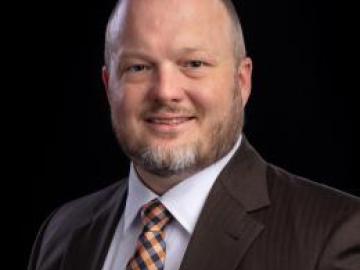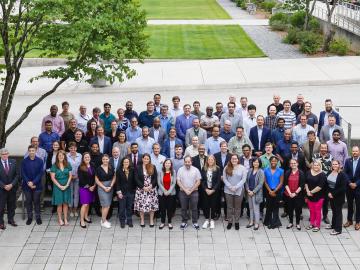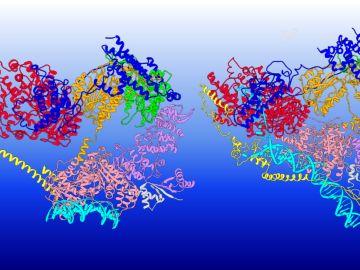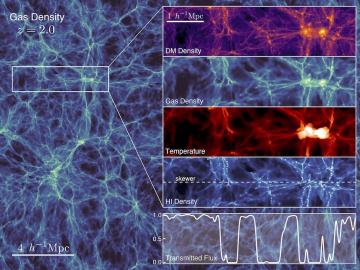
Filter News
Area of Research
- (-) Isotopes (35)
- (-) National Security (79)
- (-) Renewable Energy (4)
- (-) Supercomputing (311)
- Advanced Manufacturing (34)
- Biological Systems (18)
- Biology and Environment (177)
- Biology and Soft Matter (5)
- Building Technologies (12)
- Chemical and Engineering Materials (4)
- Chemistry and Physics at Interfaces (11)
- Clean Energy (522)
- Climate and Environmental Systems (14)
- Computational Biology (6)
- Computational Chemistry (5)
- Computational Engineering (5)
- Computer Science (19)
- Data (1)
- Earth Sciences (1)
- Electricity and Smart Grid (3)
- Energy Frontier Research Centers (14)
- Energy Sciences (5)
- Fossil Energy (3)
- Fuel Cycle Science and Technology (3)
- Functional Materials for Energy (16)
- Fusion and Fission (54)
- Fusion Energy (17)
- Geographic Information Science and Technology (3)
- Isotope Development and Production (3)
- Materials (433)
- Materials Characterization (2)
- Materials for Computing (36)
- Materials Synthesis from Atoms to Systems (13)
- Materials Under Extremes (12)
- Mathematics (1)
- Neutron Data Analysis and Visualization (4)
- Neutron Science (190)
- Nuclear Science and Technology (74)
- Nuclear Systems Modeling, Simulation and Validation (3)
- Nuclear Systems Technology (1)
- Quantum Condensed Matter (4)
- Quantum information Science (9)
- Reactor Technology (1)
- Sensors and Controls (5)
- Transportation Systems (11)
News Type
News Topics
- 3-D Printing/Advanced Manufacturing (7)
- Advanced Reactors (2)
- Artificial Intelligence (45)
- Big Data (22)
- Bioenergy (11)
- Biology (14)
- Biomedical (22)
- Biotechnology (3)
- Buildings (4)
- Chemical Sciences (5)
- Climate Change (21)
- Computer Science (104)
- Coronavirus (16)
- Critical Materials (3)
- Cybersecurity (23)
- Decarbonization (6)
- Energy Storage (10)
- Environment (26)
- Exascale Computing (22)
- Frontier (28)
- Fusion (2)
- Grid (11)
- High-Performance Computing (40)
- Hydropower (1)
- Irradiation (1)
- Isotopes (25)
- Machine Learning (23)
- Materials (20)
- Materials Science (18)
- Mathematics (1)
- Microscopy (7)
- Molten Salt (1)
- Nanotechnology (11)
- National Security (36)
- Net Zero (1)
- Neutron Science (15)
- Nuclear Energy (11)
- Partnerships (4)
- Physics (8)
- Polymers (2)
- Quantum Computing (19)
- Quantum Science (25)
- Security (14)
- Simulation (14)
- Software (1)
- Space Exploration (6)
- Summit (42)
- Sustainable Energy (12)
- Transportation (8)
Media Contacts

Wildfires have shaped the environment for millennia, but they are increasing in frequency, range and intensity in response to a hotter climate. The phenomenon is being incorporated into high-resolution simulations of the Earth’s climate by scientists at the Department of Energy’s Oak Ridge National Laboratory, with a mission to better understand and predict environmental change.

ORNL nuclear chemist Clarice Phelps has long worked to educate the next generation of STEM scientists. A new endeavor will let her reach students entering college who need extra help mastering the basics they need to pursue careers in science.

When geoinformatics engineering researchers at the Department of Energy’s Oak Ridge National Laboratory wanted to better understand changes in land areas and points of interest around the world, they turned to the locals — their data, at least.

Jacob McCulley of the Department of Energy’s Oak Ridge National Laboratory has been named a senior member of the Institute of Electrical and Electronics Engineers, or IEEE, one of the world’s largest technical professional

Experts across varied technology fields gathered ORNL to collaborate on the future of geospatial systems at the Trillion-Pixel GeoAI Challenge workshop. The third iteration of this event focused on multimodal advances in the field, including progress in artificial intelligence, cloud infrastructure, high-performance computing and remote sensing. These capabilities, when combined, can help solve problems in national and human security such as disaster response and land-use planning.

Over the past decade, teams of engineers, chemists and biologists have analyzed the physical and chemical properties of cicada wings, hoping to unlock the secret of their ability to kill microbes on contact. If this function of nature can be replicated by science, it may lead to products with inherently antibacterial surfaces that are more effective than current chemical treatments.

As extreme weather devastates communities worldwide, scientists are using modeling and simulation to understand how climate change impacts the frequency and intensity of these events. Although long-term climate projections and models are important, they are less helpful for short-term prediction of extreme weather that may rapidly displace thousands of people or require emergency aid.

Transcription factor IIH is a veritable workhorse among the protein complexes that regulate human cell activity, playing critical roles both in synthesizing DNA and in enabling DNA repair. But how can one protein assembly participate in two such vastly different jobs? A team of researchers led by chemistry professor Ivaylo Ivanov of Georgia State University used the Summit supercomputer at ORNL to tackle that question.

A research team from the University of California, Santa Cruz, have used the Oak Ridge Leadership Computing Facility’s Summit supercomputer to run one of the most complete cosmological models yet to probe the properties of dark matter.

Oak Ridge National Laboratory researchers have developed a method to simplify one step of radioisotope production — and it’s faster and safer.


